
Tuskegee Airmen
The Tuskegee Airmen were African-American pilots and crew-members who were trained by the Army Air Corps at the Tuskegee Institute in Alabama, one of the oldest and most prestigious institutes of higher learning for African Americans.
Traditionally African Americans had been barred from service in the Army Air Corps, and only a massive protest by the African-American press the first aviation cadet class began in July 1941 and completed training nine months later in March 1942. After this success, the Tuskegee program was expanded, becoming the center for training African-American aviators during World War II. They formed the 332nd Fighter Group of the U.S. Army Air Corps and its four squadrons, the 99th, the 100th, the 301st and the 302nd.
The Tuskegee Airmen included pilots, navigators, bombardiers, maintenance and support staff, instructors, and all the personnel who kept the planes in the air. Despite continuing segregation and racism in the U.S. military, these men were among the most highly respected fighter groups of World War II. From 1943 on they flew over 1,500 missions in Europe and North Africa and pilots such as Colonel Benjamin O. Davis, Jr., one of the few African-American West Point graduates at the time, became iconic figures in U.S. History.
Tuskegee Airmen shot down 112 German planes and proved conclusively that African Americans could be trained to fly and maintain sophisticated combat aircraft. The Tuskegee Airmen’s achievements, together with the men and women who supported them, paved the way for full integration of the U.S. military after World War II.

S/Sgt Joe Louis questions S/Sgt Leo E. Walker, 128-mission veteran and crew chief, about his ship “Zero Four.” Italy, August 2, 1944 (National Archives (NARA), College Park, MD).

“Okay for take-off” signals Capt. Andrew D. Turner, who flies a North American P-51 Mustang with the 332nd Fighter Group, 15th Air Force, Italy, is commanding officer of his all-black squadron. Italy, August 28, 1944 (NARA).

Lt. Andrew D. Marshall, pilot in a black fighter group of the Mediterranean allied air force tells a fellow pilot how he escaped death when his plane was shot down. Italy, October 25, 1944 (NARA).

Capt. Andrew D. Turner Commanding Officer of a squadron of the 332nd Fighter Group, 15th Air Force and Lt., Clarence P. (Lucky) Lester, discuss a recent mission. Italy, August 28, 1944 (NARA).

Capt. Armour G. Daniels, Squadron Operations officer points out a cannon hole. Italy, February 17, 1945 (NARA).

Shattered tail assemblies in a bomb damaged Bachman von Blumenthal Company’s ME-110 factory at Furth, Germany, 28 April 1945 (NARA).
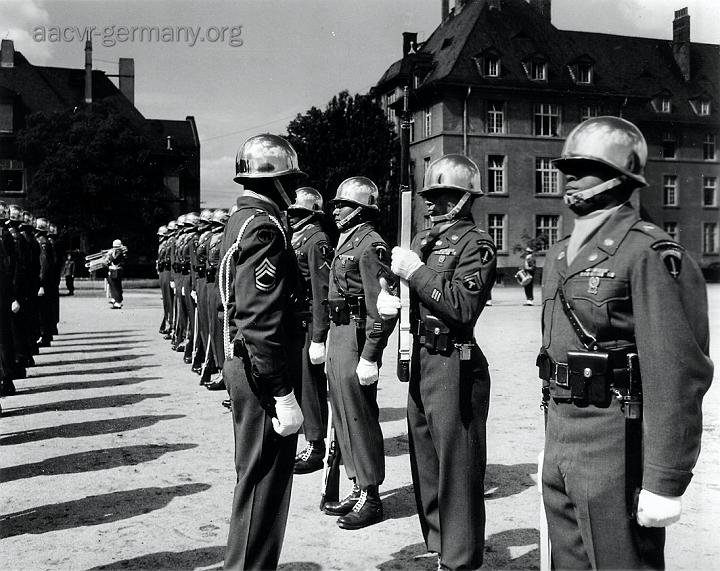
A view of the 7777th (Inf) Honor Guard Platoon as they stand an inspection by a T/Sgt of the platoon. Frankfurt, Germany, July 16, 1948 (NARA).
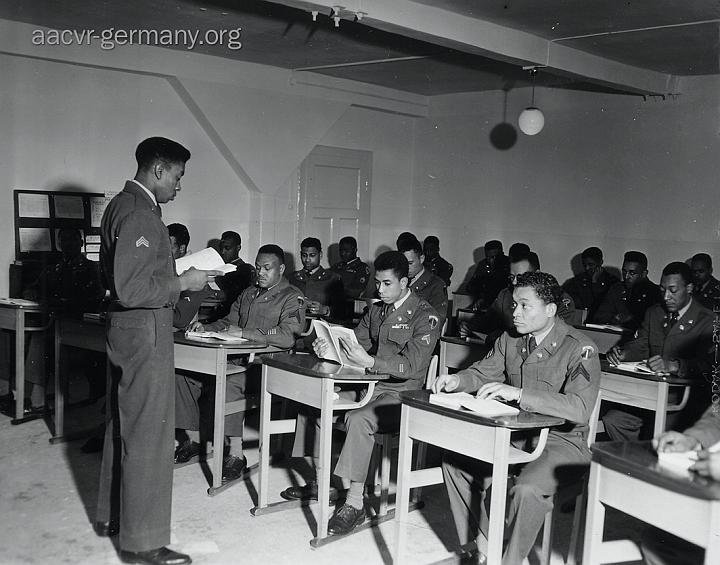
An English class taught to Personnel of the 76th T.T. Co by Cpl. Leroy Curtis. Frankfurt, Germany, February 26, 1951 (NARA).

Col. Benjamin O. Davis, graduate of West point and Commanding Officer of the all-black 332nd Fighter Group 15th Air Force, Italy, in front of large scale map of Europe as he briefs his pilots before a mission (NARA).

African American pilots of the 332nd Fighter group being briefed before a mission. Italy, August 28, 1944 (NARA).

Sgt. Wm. Accoo of the all-black 332nd Fighter Group, 15th Air Force, Italy washing his plane down with soap and water. Italy, 1944 (?) (NARA).

Gen. John. K. Cannon, commander 12th USAAF, congratulates Capt. C.B. Hall of the 99th all-black Fighter Squadron, who shot down two German planes over bridgehead south of Rome. Italy, January 29, 1945 (NARA).
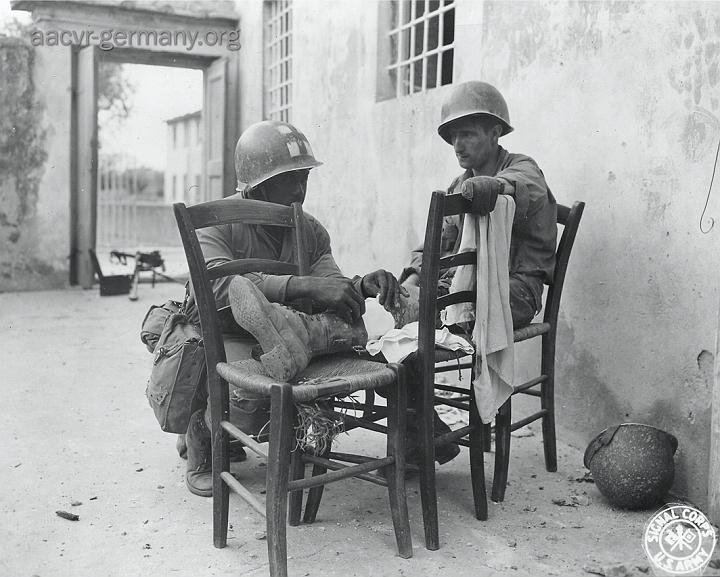
Medic Charles Jones bandages the leg of a Pfc Thomas W. Skayhan, 1st armored div., a few hundred yards south of the walls of Lucca, Italy, September 5, 1944 (NARA).
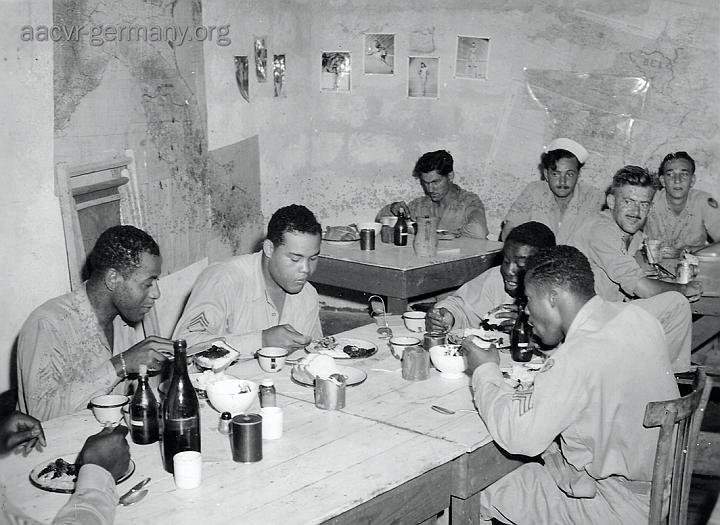
S/Sgt Joe Louis visiting a heavy bomber base in Italy and eating after a show in the ring for combat crews that had returned from their day’s mission over Germany. Italy, September 21, 1944 (NARA).

Gen. Benjamin O. Davis pins the distinguished flying Cross on his son, col. Benjamin O. Davis, Jr. Capt. Joseph D. Elsberry, and 1st Lt. Clarence d. Lester, await their turn to be decorated. Italy, November 13, 1944 (NARA).

“This cozy home, built in six days by Sgt. Fred Robinson, boasts hot and cold running water, sink, poker table and service bar.” Italy, October 31, 1944 (NARA).

Pilots of the 15th AAF Squadron in front of the “the three minute egg” club, named after the often only 3 minutes of flying time they have left in their tank to return to their base after long missions over enemy territory. Italy, October 31, 1944 (NARA).

Lt. George R. Bolling, Capt. Erwin B. Lawrence, Jr. and Capt. Leon C. Roberts of the all-black original fighter squadron. Italy, July 11, 1944 (NARA).

North American P51 Mustangs of the all-black Fighter Group, 15th AAF. Their planes all use wing tanks for the extra distance required for escorting heavy bombers on raids. Italy, 1944 (?) (NARA).
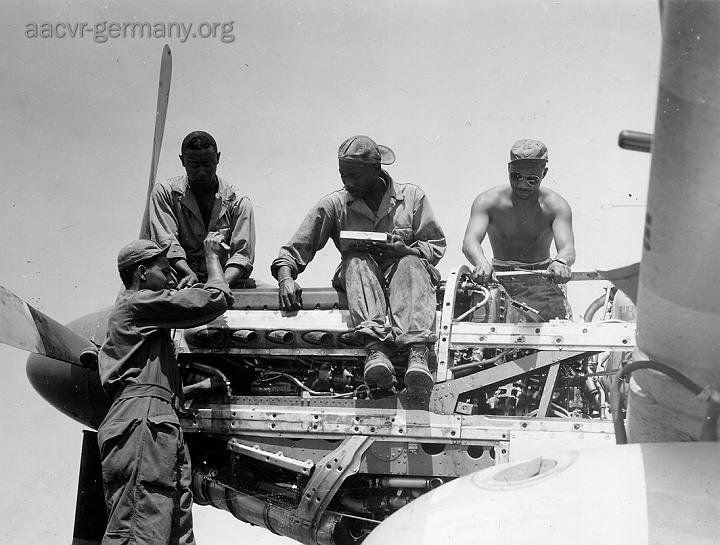
Mechanics of the 332nd Fighter Group of the 15th AAF: S/Sgt Calvin P. Thierry, S/Sgt William e. Pitts, S/Sgt Vernon C. Richardson, S/Sgt Harold t. Cobb. Italy, August 2, 1944 (NARA).

Pfc. John T. Fields, an armorer with the all-black 332nd Fighter Group, 15th AAF, Italy, inspects the ammunition in the North American P-51 Mustang he services. Italy, August 2, 1944 (NARA).

Sergeant Armorer and his helpers pack .50 cal. Ammunition into a Mustang’s wing. Italy, February 17, 1945 (NARA).

Armorer removes machine gun from P-51 for routine inspection. Italy, February 17, 1945 (NARA).
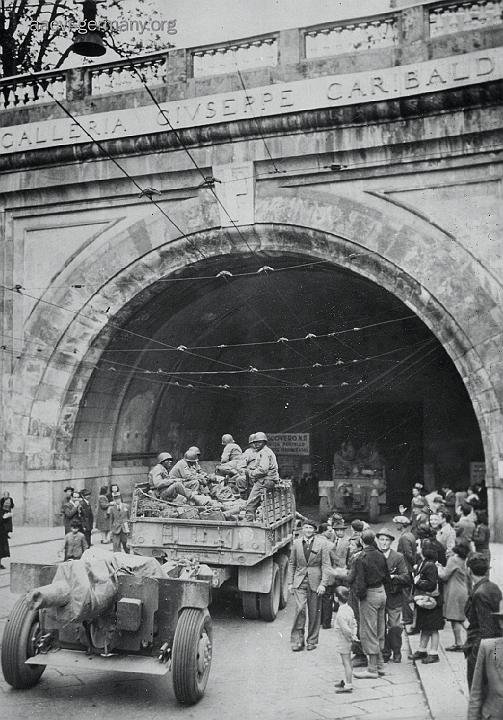
American Guns and troops of the fifth army enter the Garibaldi tunnel in Genoa after the city’s liberation. Italy, May 1, 1945 (NARA).

Tank Crew Trainees brush up on their marksmanship on the grounds of the Armored School Detachment, Replacement and Training command in Naples. Italy, July 25, 1945 (NARA).